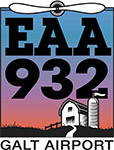I’ve been flying area navigation (RNAV) approaches with a Garmin 430W for a few years now and one thing has always confused me. When I select the RNAV approach for an airport I’ve never been sure which level of minimums the unit is going to give me because it doesn’t necessarily match what is listed on the approach plate.
For example, the briefing strip on the RNAV (GPS) RWY 11 approach plate for Burlington (BUU) indicates it is a WAAS approach, however, the only minimums listed are LP and LNAV (i.e. no vertical guidance). When I fly the approach my GPS indicates LP+V and I get a helpful glide slope on my HSI. I decided to dig into it a bit more to unravel the mystery.
One key thing I learned was that the WAAS system evaluates the lowest minimums available and displays the corresponding minimums in the approach mode annunciator. Here is an explanation of all the options you might see.
LNAV
LNAV is the most basic of the GPS options providing lateral navigation only and can be flown without WAAS. The lateral sensitivity of the CDI needle is 0.3nm all the way from the final approach fix (FAF) to the missed approach point (MAP.) You would fly this approach down to the MDA using your barometric altimeter.
LP
Localizer performance (LP) is another lateral guidance only option but it is only available to WAAS-capable GPS units. LP uses the WAAS CDI sensitivity capability, which increases from 0.3nm at the FAF to 350 feet at the threshold. In this regard it works very similar to a localizer approach. You still fly this down to the MDA using your barometric altimeter but it can get you up to 60 feet closer to the runway than an LNAV approach.
LP+V or LNAV+V
If you see LP+V or LNAV+V in your GPS approach annunciator you will automatically receive advisory vertical guidance, similar to an ILS glide slope. This is a mathematically-calculated glide slope that provides a steady descent from the FAF to the visual descent point (VDP). It is important to be aware that that the advisory glide slope does not always ensure obstacle clearance and you must still use your barometric altimeter to meet all altitude restrictions (i.e. “step down” minimum altitudes). LP+V and LNAV+V are not listed on FAA approach plates but if you use Jeppesen charts they will indicate an advisory glide slope in the profile view.
LNAV/VNAV
LNAV/VNAV minimums are designed for baro-aided GPS receivers that receive vertical guidance from a non-satellite navigation source, such as a pitot-static system. This provides both lateral and approved vertical guidance. This type of approach is flown down to a decision altitude (DA) instead of an MDA. You don’t need WAAS capability to fly LNAV/VNAV and the CDI sensitivity does not increase as the aircraft gets closer to the runway.
LPV
Localizer performance with vertical guidance (LPV) minimums are only available for WAAS-equipped GPS receivers and offer the lowest minimums of all the GPS options. With LPV the CDI needle becomes more sensitive the closer you get to the runway, just like a localizer. LPV also provides approved vertical guidance similar to an ILS glide slope down to a DA, sometimes as low as 200 feet AGL.
With or without a glide slope, all RNAV approaches are considered non-precision because they don’t meet the ICAO standards for a precision approach. However, for the purposes of a instrument rating practical test, LPV can be used to demonstrate precision approach proficiency if the DA is equal to or less than 300 feet height above touchdown (HAT).
For more information you can consult your GPS manual. But if you are really interested in learning more about GPS approaches I highly recommend Max Trescott’s GPS and WAAS Instrument Flying Handbook for GNS 430/430W, 530/530W, G1000, G900X, Perspective and GNS 480.
Beth Rehm, CFI

